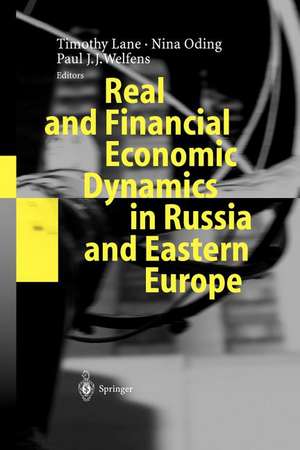Real and Financial Economic Dynamics in Russia and Eastern Europe
Editat de Timothy Lane, Nina Oding, Paul J.J. Welfensen Limba Engleză Paperback – 2 sep 2012
| Toate formatele și edițiile | Preț | Express |
|---|---|---|
| Paperback (1) | 641.20 lei 6-8 săpt. | |
| Springer Berlin, Heidelberg – 2 sep 2012 | 641.20 lei 6-8 săpt. | |
| Hardback (1) | 647.59 lei 6-8 săpt. | |
| Springer Berlin, Heidelberg – 17 iun 2003 | 647.59 lei 6-8 săpt. |
Preț: 641.20 lei
Preț vechi: 754.36 lei
-15% Nou
Puncte Express: 962
Preț estimativ în valută:
122.71€ • 127.38$ • 102.32£
122.71€ • 127.38$ • 102.32£
Carte tipărită la comandă
Livrare economică 22 martie-05 aprilie
Preluare comenzi: 021 569.72.76
Specificații
ISBN-13: 9783642624674
ISBN-10: 3642624677
Pagini: 312
Ilustrații: XI, 297 p.
Dimensiuni: 155 x 235 x 16 mm
Greutate: 0.44 kg
Ediția:Softcover reprint of the original 1st ed. 2003
Editura: Springer Berlin, Heidelberg
Colecția Springer
Locul publicării:Berlin, Heidelberg, Germany
ISBN-10: 3642624677
Pagini: 312
Ilustrații: XI, 297 p.
Dimensiuni: 155 x 235 x 16 mm
Greutate: 0.44 kg
Ediția:Softcover reprint of the original 1st ed. 2003
Editura: Springer Berlin, Heidelberg
Colecția Springer
Locul publicării:Berlin, Heidelberg, Germany
Public țintă
ResearchDescriere
Russia and many other transition countries are now facing the challenges of opening up, restructuring, and modernizing their economies, which requires addressing numerous institutional weaknesses and supply-side distortions. The papers in this collection examine these issues both in Russia and from a regional perspective, drawing on the experience of other reforming countries. Aspects addressed include the implications of trade and capital flows, the process of labor market reform, financial market development, productivity growth, and innovation dynamics. The dynamics of the reform process are also studied in the context of new political economy models.
Cuprins
A. Capital Flows to Transition Economies: Reasons, Risks, and Policy Responses.- 1 Introduction.- 2 Capital Flows and their Motivation.- 2.1 Real Appreciations and Interest Rate Differentials.- 2.2 Capital Scarcity.- 2.3 What Limits Capital Flows to Transition Economies?.- 2.4 Risks Associated with Capital Inflows.- 3 Policy Responses to Capital Inflows.- 3.1 Exchange Rate Regime.- 3.2 Fiscal Policy.- 3.3 Structural Reforms.- 3.4 Capital Controls.- 3.5 Transparency.- 4 Conclusion.- Appendix: Figures and Tables.- References.- B. Long Term Structural Change and Productivity Growth in Russia.- 1 Point of Reference.- 2 Strategy for Russia.- 3 Economic Growth and the Investment Climate.- 4 Efficiency, Competition, Institutions.- 5 Macroeconomics.- 6 Domestic Demand and Demographics.- 7 The Widening Technological Gap is a Threat to Russia's Future.- References.- C. Innovation, Growth and Wage Structure in Transforming Economies.- 1 Introduction.- 2 Innovation and Growth: Where do the Transition Countries Stand?.- 3 Learning by Exports: A Feasible Perspective?.- 4 Learning from Asian NICs.- 5 Structural Change and Wage Structure in a Period of Economic Opening up and Growth.- 6 Conclusions.- References.- D. Financial Sector and Human Capital in a Long-Term Growth Perspective: The Case of Russia.- 1 Introduction.- 2 The Importance of Financial Markets and Human Capital from Growth Theory Perspectives and Empirical Evidence.- 2.1 Financial Sector and Growth.- 2.2 Human Capital and Growth.- 3 Conclusion and Policy Options.- References.- E. Structure and Growth of Private Consumption in Russia and East Germany.- 1 Introduction.- 2 Statistical Definitions of Private Consumption.- 3 General Factors Influencing Private Consumption.- 4 Structure and Growth of Private Consumption in East Germany.- 5 Final Consumption in Russia.- 6 Conclusions.- References.- F. Labor Market Transformation and Hidden Unemployment in Russia.- 1 Introduction.- 2 The Main Features of the Labor Market.- 3 Employment/ Unemployment Statistics in Russia.- 4 Hidden Unemployment.- 5 Enterprise Behavior and Employment Policy.- 6 The Case of St. Petersburg.- 7 Concluding Remarks.- References.- G. Principles of Market-Oriented Labor Market Policies.- 1 Introduction.- 2 The Case for Active Manpower Policy.- 3 Active Labor Market Policy in the United States.- 4 Evaluation of U.S. Employment and Training Programs.- 5 Interpretation of the U.S. Evidence.- 6 European Evidence.- 7 Concluding Remarks.- References.- H. Rent-Seeking and Rent-Setting: Government Versus Competition (The Case of St. Petersburg).- 1 Introduction.- 2 Industrial Policy and Rent-Seeking.- 3 Rent-Seeking Through Social Merit.- 4 The Vesting of Monopoly Power.- 5 Licensing as Rent-Seeking.- 6 Protectionism.- 7 Conclusion.- References.- I. Powerful Groups and Corruption.- 1 Introduction.- 2 The Power Index Model.- 3 Conclusion.- References.- J. Regional Dimension of the Market Transformation in Russia.- 1 Introduction.- 2 Nonmarket Characteristics of the Russian Economic Space.- 3 Political and Economic Factors of Decentralization.- 4 Characteristics of the Economic Policy Pursued by Subjects of the Russian Federation.- 5 Some Results of Decentralization.- 6 A Change in the Federal Center's Position and Imperatives of the Regional Policy.- 7 Political Imperatives of Harmonizing Economic Relations between the Center and Regions.- K. Foreign Trade Policies in Transformational Russian and Ukrainian Economies.- 1 Introduction.- 2 Global Capital Movements and Capital Flows.- 3 Foreign Trade Policies in Russia and Ukraine in Transition.- 4 Foreign Trade Policy Instruments.- References.- L. The Role of Foreign Direct Investment in Transformation.- 1 Theoretical Background.- 2 Statistical Background.- 3 Determinants of FDI and Projections for Selected CIS and other Eastern European Countries.- 3.1. Determinants of FDI.- 3.2. Projections for Investigated CIS Countries and Eastern European Countries.- 4 FDI, Capital Formation, and Structural Change.- 4.1. The Size of Gross Fixed Capital Formation.- 4.2. The Contribution of FDI to Capital Formation.- 4.3. Sectoral Aspects.- 5 Conclusions.- References.- M. Data Appendix.- List of Figures.- List of Tables.- List of Contributors.- Biographies.
Caracteristici
Includes supplementary material: sn.pub/extras















